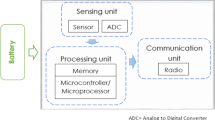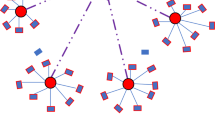Abstract
Mobility management in a cluster-based, multihop ad hoc network is studied. It is shown that the process of clustering the network into groups of stations has similarities to data analysis, in particular, pattern recognition. In data analysis, the term clustering refers to the process of unsupervised learning, which also describes the situation in a mobile ad hoc network.
In this paper, existing data-clustering algorithms are first classified into different categories. Some of the most important types of algorithms are afterwards described, and their applicability to the problem of mobility management in an ad hoc network is studied. It is shown that most of the pattern-recognition algorithms are not suited to the application under consideration.
This is why we have developed a new clustering scheme that incorporates some of the ideas of the data classification schemes. The new clustering scheme is based on a rule-based fuzzy inference engine. The main idea consists of the consideration of dynamic clustering events chosen as a consequence of the fuzzy rules. Four types of clustering events are considered.
The performance of the clustering algorithm has been evaluated by computer simulation.
Similar content being viewed by others
REFERENCES
M. Gerla and J. Tzu-Chieh Tsai, Multicluster mobile, multimedia radio network, Wireless Networks, Vol. 1, pp. 255–265, Oct. 1995.
C. R. Lin and M. Gerla, Adaptive clustering for mobile wireless networks, IEEE J. Select. Areas Commun., Vol. 15, pp. 1265–1275, Sept. 1997.
J. Habetha, M. Nadler, and D. Calvo de No, Dynamic clustering with quality of service guarantees and forwarder selection in wireless ad hoc network. In Proc. Asia Pacific Conference on Communications, pp. 31–35, Nov. 2000.
J. Habetha, A. Hettich, J. Peetz, and Y. Du, Central controller handover procedure for ETSI-BRAN HiperLAN/2 ad hoc networks and clustering with quality of service guarantees. In IEEE Annual Workshop on Mobile Ad Hoc Networking & Computing (Mobi-HOC), pp. 131–132, Aug. 2000.
J. Habetha and M. Nadler, Concept of a wireless centralised multihop ad hoc network. In Proc. European Wireless, (Dresden), Sept. 2000.
B. McDonald and T. F. Znati, A mobility-based framework for adaptive clustering in wireless ad hoc networks, IEEE J. Select. Areas Commun., Vol. 17, pp. 1466–1487, Aug. 1999.
T. J. Kwon and M. Gerla, Clustering with power control. In Proc. MILCOM, Nov. 1999.
J. Habetha and M. Nadler, Outline of a centralised multihop ad hoc wireless network, Computer Networks, Vol. 37, pp. 63–71, 2001.
D. A. Baker and A. Ephremides, The architectural organization of a mobile radio network via a distributed algorithm, IEEE Trans. on Commun., Vol. 29, pp. 1694–1701, Nov. 1981.
A. Ephremides, J. E. Wieselthier, and D. J. Baker, A design concept for reliable mobile radio networks with frequency hopping signaling, Proc. of the IEEE, Vol. 75, pp. 56–73, Jan. 1987.
J. Habetha and J. Wiegert, A comparison of new single-and multiple-transceiver data forwarding mechanisms for multihop ad hoc wireless networks. In Proc. Int. Symposium on Performance Evaluation of Computer and Telecommunication Systems, (Orlando), pp. 436–443, July 2001.
B. Walke, N. Esseling, J. Habetha, A. Hettich, A. Kadelka, S. Mangold, and J. Peetz, IP over wireless mobile ATM-Guaranteed wireless QoS by HiperLAN/2, Proc. of the IEEE, Vol. 89, pp. 21–40, Jan. 2001.
B. Walke, Mobile Radio Networks, 2nd ed., Wiley & Sons Ltd., Chichester, Sussex, UK, 2001.
J. C. Bezdek, Pattern Recognition with Fuzzy Objective Function Algorithms, Plenum, New York, London, 1981.
K. S. Fu, Syntactic Methods in Pattern Recognition, Academic Press, New York, 1974.
K. S. Fu, Syntactic Pattern Recognition with Applications, Prentice-Hall, Englewood Cliffs, New Jersey, 1982.
L. A. Zadeh, Fuzzy sets, Inform. Control, Vol. 8, pp. 338–353, 1965.
D. Dubois and H. Prade, Fuzzy Sets and Systems: Theory and Applications, Academic Press, New York, London, Toronto, 1980.
H.-J. Zimmermann, Fuzzy Set Theory-and Its Applications, 3rd ed. Kluwer, Boston, Dordrecht, London, 1996.
J. C. Dunn, A fuzzy relative of the ISODATA process and its use in detecting compact, well-separated clusters, J. Cybernetics, Vol. 3, No. 3, pp. 32–57, 1973.
G. H. Ball and D. J. Hall, ISODATA, an iterative method of multivariate analysis and pattern classification, Behavioural Science, Vol. 12, pp. 153–155, 1967.
R. Duda and P. Hart, Pattern Classification and Scene Analysis, Wiley, New York, 1973.
F. Höppner, F. Klawonn, and R. Kruse, Fuzzy-Clusteranalyse: Verfahren für die Bilderkennung, Klassifikation und Datenanalyse, Vieweg, Braunschweig, 1996.
D. E. Gustafson and W. C. Kessel, Fuzzy clustering with a fuzzy covariance matrix. In Proc. of IEEE CDC (San Diego, California), pp. 761–766, Jan. 1979.
I. Gath and A. B. Geva, Unsupervised optimal fuzzy clustering, IEEE Transactions on Pattern Analysis and Machine Intelligence, Vol. 11, pp. 773–781, July 1989.
J. F. Peters, A. Skowron, Z. Suraj, S. Ramanna, and A. Paryzek, Modeling real-time decision-making systems with rough fuzzy Petri Nets. In Proc. EUFIT'98 (Aachen), pp. 985–989, ELITE Foundation, 1998.
L. Minsky, A framework for representing knowledge. In R. Brachman and H. Levesque (eds.), Readings in Knowledge representation Morgan Kaufmann, Los Altos, 1985.
L. A. Zadeh, Outline of a new approach to the analysis of complex systems and decision processes, IEEE Transactions on Systems, Man and Cybernetics, Vol. 16, No. 3, pp. 28–44, 1973.
O. Cordon, M. J. del Jesus, and F. Herrera, A proposal on reasoning methods in fuzzy rule-based classification systems, Int. J. on Approximate Reasoning, Vol. 20, No. 1, pp. 21–45, 1999.
L. I. Kuncheva, How good are fuzzy if-then classifiers? IEEE Transactions on Systems, Man and Cybernetics-Part B: Cybernetics, Vol. 30, pp. 501–509, Aug. 2000.
H. Bandemer and W. Näther, Fuzzy Data Analysis, Kluwer, Dordrecht, Boston, London, 1992.
A. Joentgen, L. Mikenina, R. Weber, and H.-J. Zimmermann, Dynamic fuzzy data analysis based on similarity between functions, Fuzzy Sets and Systems, Vol. 105, No. 1, pp. 81–90, 1999.
L. Mikenina, Dynamic Fuzzy Pattern Recognition. Ph.D. thesis, RWTH Aachen, 1999.
S. Mann, Ein Lernverfahren zur Modellierung zeitvarianter Systeme mittels unscharfer Klassifikation. Ph.D. thesis, Technische Hochschule Karl-Marx-Stadt, 1983.
B. Dubuisson, An adaptive decision system using pattern recognition, Artificial Intelligence in Real-Time Control, pp. 299–302, 1992.
S. Marsili-Libelli, Adaptive fuzzy monitoring and fault detection, Int. J. of Condition Monitoring and Diagnostic Engineering Management (COMADEM), Vol. 1, No. 3, pp. 31–37, 1998.
E. H. Mamdani and S. Assilian, An experiment in linguistic synthesis with a fuzzy logic controller, Int. J. Man-Machine Studies, No. 7, pp. 1–13, 1975.
M. Junius, Leistungsbewertung intelligenter Handover-Verfahren für zellulare Mobilfunksysteme. Ph.D. thesis, RWTH Aachen, 1995.
G. Edwards, A. Kandel, and S. Ravi, Fuzzy handoff algorithms for wireless communication, Fuzzy Sets and Systems, Vol. 110, pp. 379–388, 2000.
D. Driankov, H. Hellendoorn, and M. Reinfrank, An Introduction to Fuzzy Control, 2nd ed., Springer, Berlin, 1996.
D. Johnson and D. A. Maltz, Dynamic Source Routing in Ad Hoc Wireless Networks. In T. Imielinski and H. Korth (eds.), Mobile Computing Kluwer Academic Publishers, Norwell, Massachusetts, 1996.
J. Broch, D. A. Maltz, D. B. Johnson, et al., A performance comparison of multi-hop wireless ad hoc network routing protocols. In Proc. ACM/IEEE International Conference on Mobile Computing and Networking (MOBICOM), pp. 85–97, Oct. 1998.
S. Das, C. Perkins, and E. M. Royer, Performance comparison of two on-demand routing protocols for ad hoc networks. In Proc. IEEE INFOCOM, Mar. 2000.
J. Habetha and D. Calvo de No, Hierarchical time-vector routing for mobile ad hoc networks. In Proc. IEEE International Conference on Communications (ICC), Helsinki, June 2001.
Author information
Authors and Affiliations
Rights and permissions
About this article
Cite this article
Habetha, J., Walke, B. Fuzzy Rule-Based Mobility and Load Management for Self-Organizing Wireless Networks. International Journal of Wireless Information Networks 9, 119–140 (2002). https://doi.org/10.1023/A:1015355817270
Issue Date:
DOI: https://doi.org/10.1023/A:1015355817270




